

By
Don and Linda Freedman
Search TheTravelzine
TheTravelzine Group
Access Your Mail
Don's Gallery
Packing Hints
Planning Tips
Cities Links
Links
LINKS TO OUR TRAVELOGUES
Argentina, Buenos Aires - Jan-Mar 2010
Argentina, Buenos Aires - Jan-Mar 2009
Argentina, Buenos Aires - Jan-Mar 2008
Austria - Fall 2005
Belgium, Brussels - Fall 2000
Canada - Summer 2002
Canada - Summer 2001
Canada - Summer 2000
Czech Republic - Spring 2000
France - Fall 2002
France, Paris - Fall 2000
France, Paris - Spring 1999
France, Lyon - Spring 1999
Germany, Berlin - Fall 2009
Germany - Fall 2002
Germany - Spring 2000
Germany - Fall 1999
Greece - Fall 2012
Greece - Fall 1999
Greece - Fall 1997
Hungary - Spring 2000
Israel - Fall 1999
Italy - Winter 2007
Italy - Winter 2006
Italy - Winter 2005
Italy - Winter 2004
Italy - Winter 2003
Italy - Winter 2001
Italy - Fall 1998
Italy - Fall 1996
Netherlands - Spring 2000
Portugal, Azores - 2019
Portugal, Azores - 2018
Portugal, Sao Miguel & Lisbon - 2017
Portugal, Azores - 2017
Portugal, Azores - 2016
Portugal, Azores - 2015
Portugal, Azores - 2014
Portugal, Azores - 2013
Portugal, Azores - 2012
Portugal, Azores - 2011
Portugal, Lisbon - 2011
Portugal - Fall 2006
Portugal - Fall 2004
Portugal - Fall 2003
Portugal - Fall 2001
Portugal - Spring 1999
Portugal - Spring 1997
Slovakia - Spring 2000
Slovenia - Spring 1999
Slovenia - Fall 1996
Spain, Barcelona - Winter 2006
Switzerland - Fall 2002
Switzerland - Spring 2000
Switzerland - Spring 1999
Switzerland - Fall 1998
Switzerland - Fall 1997
Switzerland - Spring 1996
U.S. Florida, Key West - Fall 2006
U.S. Florida - Spring 2001
U.S. Maine - Summer 2002
U.S. Massachusetts - Summer 2003
U.S. Massachusetts - Summer 2002
U.S. Massachusetts - Summer 2001
U.S. New York State - Fall 2005
U.S. New York State - Summer 2004
U.S. New York State - Summer 2003
U.S. New York State - Summer 2001
U.S. Washington,DC - Spring 2000
BARCELONA,
SPAIN
WINTER 2006
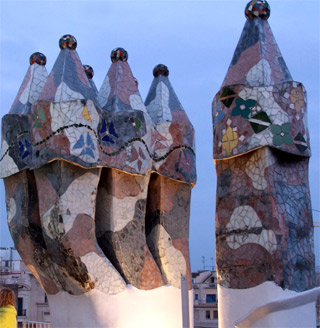
We had wanted to visit Barcelona for years, so when we found an incredibly low fare from Roma on Vueling Airlines, we grabbed it. The flight operated between the two main airports, FCO Roma and BCN Barcelona, an unexpected bonus considering that it's a discount carrier.
The Vueling staff at check-in and onboard was welcoming and cheerful. The Airbus 320-200 was clean and comfortable with ample leg room and seat width. It was nice to see the staff offering assistance to passengers placing their luggage in the overhead compartments and looking after their overall comfort. Snacks, sandwiches and beverages are sold onboard. Hard candies are offered free before landing.
We departed on time and arrived ten minutes early after a one and a half hour flight. With just carry-ons, we were quickly on our way to the waiting Aerobus at the arrivals entrance and for 3.60 euro p.p., we were in the city center at Plaša Catalunya 30 minutes later. As in Roma, the weather was crisp and sunny, 10-13C, throughout our stay.
It was a short walk to the Avenida Palace hotel, one block north of Plaša Catalunya, at Gran Via Corts Catalanes 605-607, between Rambla de Catalunya and Passeig de Gracia, a perfect location at excellent low season rates this time of year.
We were impressed with the elegance of the lobby and bi-level lounge area. The greeting was cool and abrupt as was all interaction. The hotel prides itself on offering "classical Catalonian hospitality in a privately managed hotel" which implies a front desk and management staff that generates a feeling of warmth, caring and commitment to the clients' comfort. We squeezed out a few smiles here and there but it was a struggle.
There's a business center but unfortunately there is a charge (unusually high) for internet use so we didn't give them our business.
While our twin-bedded room was very large with nice furniture and good closet space, the furnishings were tired and the lighting very poor, resulting in a dreary environment. Although our room faced a major boulevard, the double windows provided peace and quiet. The large bathroom had the convenience of twin sinks with a separate toilet and bidet room.
The housekeeping staff was very pleasant and accommodating but somewhat inconsistent in their efforts. When we arrived the carpeting was dirty and throughout our stay amenities were not replaced in the bathroom. Bathrobes showed up after 4 days of our 6 day stay and the bedspread was not put on the last day, etc. Other than the dirty carpet, these are not serious issues but are reflective of an indifferent management style.
Barcelona started life at the sea and as the city expanded it developed a dynamic and thriving urban life while maintaining the culture of the old city center and enhancing the natural assets of its waterfront. The 1992 Olympic Games served as a catalyst for infrastructure projects and large urban space development from 1987 to l992 and continued thereafter.
Standing at the waterfront in
Plaša de la Pau at the tall Columbus Lookout you are at
the foot of La Rambla, the famous wide boulevard that
runs north through the old city center to Plaša
Catalunya. To the west overlooking the harbor is Montjuic,
a gorgeous green mountain where development began with
the l929 World's Fair and continued for the 1992 Olympic
Games. The Museu Nacional d'Art Catalunya, fairgrounds,
the Olympic Ring, Jardi Botanic, and Ciutat del Teatre
are some of the essential venues on this lovely hill.
[Back
to Top]
La Rambla divides the 3 districts of the old city - to the west is The Raval and to the east The Gothic Quarter and The Ribera. The Old Port and Barceloneta fan out along the coast toward the Olympic Village and the wonderful parks and beaches to the east.
The Plaša Catalunya was created at the northern part of the old city center and serves as the divide to the new urban areas. It is a huge circular space with a park at its center, surrounded by commercial and public buildings. For a city famous for its architecture (justifiably so) this Plaša of transition is a disappointment, but it's only a few steps to redemption.
The Eixample or "enlargement" reflects the urban enrichment in the central area of the city formed by a grid with diamond shaped intersections (the buildings on all four corners of the intersections have been designed with diagonal frontage), which creates a wide open visual panorama as well as a practical and efficient pedestrian and vehicular traffic flow.
North of Plaša Catalunya two parallel boulevards, Rambla de Catalunya and Passeig de Gracia, with fabulous wide center pedestrian walkways, extend to Av.Diagonal and form the core of the Eixample. Within this core is the epicenter of "Modernista" Barcelona which architectural style took root at the end of the 19th century into the first two decades of the 20th, highlighted by the brilliant works of Antoni GaudÝ, the name most associated with the city.
This is where we began our 6 days
of walking the diverse streets of Barcelona. As many
before us, we were totally captivated by the beauty of
the architecture. We stopped dead in our tracks at #35
Passeig de Gracia, the beginning of "Mansana de la
Discordia", a single residential block that unites
three marvelous examples of the best of modernista
architecture. Most remarkable is that all three are
refurbished buildings, all the more challenging for the
architects. Casa Albert Lleo Morera by Lluis Domenech i
Montaner showcases the period of the architects floral
style. The interior is a brilliant ensemble of modernista
mosaics, sculpture, ceramics and stained glass. 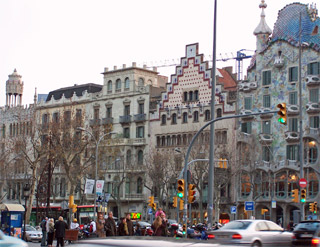
Adjacent at #41 is Josep Puig i
Cadafalch's, Casa Amatller. We were initially fascinated
by the colorful triangular shaped step up roof line, then
the beauty of the rest of the fašade commanded our
attention. The combination of polychrome ceramic, wrought
iron, sculpture in stone and marble and sgraffito work is
a feast of decorative art. Looking into the entrance hall
we could see striking bronze lamps and a graceful
stairway leading to the first floor.
[Back
to Top]
Next in line at #43 is Casa Batllo,
one of many GaudÝ creations. It is easy to be
overwhelmed by his work. It is like no other most of us
have ever seen. The symphony of designs, shapes,
materials and colors creates a lifelike being that in
fact is a building filled with surprises at every turn.
So it is with Casa Batllo. The intrigue begins with the
shape and colorful materials of the roof. GaudÝ's
symbols dominate the entire building. The popular
interpretation is that the fašade represents the dragon
(his most dominant symbol) which has been impaled on St.
George's sword. The tiles are the dragon's scales and the
balconies and shapes (which look like body parts) on the
lower fašade are the bones of its victims. The exquisite
entrance begins a journey through some of the interior
where the unusual shapes and curves were designed to be
architecturally stimulating yet allowed practical living
space. We climbed to the rooftop where we were fascinated
by the mysterious chimneys and the famous 3-dimensional
cross which crowns the building.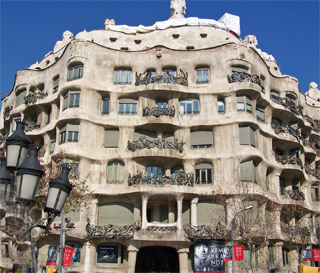 The chimneys are
organic sculptures abstractly covered by pieces of
colored glass. Graceful shape, invigorating color and
texture make these chimneys truly a reflection of the
genius of GaudÝ.
The chimneys are
organic sculptures abstractly covered by pieces of
colored glass. Graceful shape, invigorating color and
texture make these chimneys truly a reflection of the
genius of GaudÝ.
This masterful modernism is again
found at #92 Passeig de Gracia, Casa Pere Mila i Camps or
better known a "La Pedrera" (the stone quarry),
declared a World Heritage Site by UNESCO. This was GaudÝ's
last residential block built in Eixample. A dominating,
architectural force demanding attention, it is an
authentic abstract sculpture with curves dominating the
stone of the fašade, the balconies and balcony railings,
the lobby and the courtyard.
[Back
to Top]
The ultimate GaudÝ project is the Temple de la Sagrada Familia. This was his true labor of love. The construction began in 1882 and one year later GaudÝ was appointed Project Manager. He worked on it for 40 years until his death in 1926. The overall plan and use of innovative geometrical shapes of naturalist style (GaudÝ's hallmarks) are the basis on which architects continue the work he started so long ago.
As we found our way toward the
unfinished church, the sight of the 8 finished bell
towers dedicated to the Apostles (4 more to be built),
each exceeding 100 meters, came into view. By now we were
comfortable with the GaudÝ look, but this was unreal,
like coming upon a fairyland. Also emerging were huge
cranes for the construction of the 4 belfries, the
Fašade of Glory (170 meters) central dome in honor of
Jesus Christ, the Tower of the Virgin Mary (125 meters)
and the Tower of the 4 Evangelists. 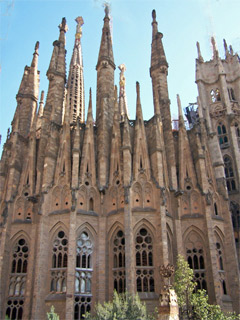
There are 3 main fašades, Nativity to the east, Death on the west and Glory to the south. The Nativity fašade is decorated with organic forms.
The vaults of the main naive are finished and work is now focused on the transepts and apse. It is incredible to see the complicated structural system of inclined columns and parabolic arches of the naves. The apse is adorned with unusual and original plant and animal motifs.
Before walking through the unfinished interior, we visited the museum depicting the past, present and future of the Temple. There is an abundance of well-organized scale models, photographs, plans and decorative objects on display.
This amazing project, ongoing since
1882 with no defined completion date, is not to be missed.
[Back
to Top]
On Arago 255 is the iron and brick building by Domenech i Montanar which currently houses the Fundacio Antoni Tapies. The decorative brickwork, ground floor railings with whiplash motif and unpainted terracotta cornice are distinctive. Most intriguing are the dazzling sculptures crowning the roof.
The Paulu Baro de Quadras by Josep Puig i Cadafalch at Av. Diagonal 373 has double frontage. The main fašade on Av. Diagonal, in the style of a Gothic period mansion, looks like a single family town house while the fašade overlooking Carrer Rossello has the features of a residential apartment building. The building is now the "House of Asia". The entrance hall has magnificent tile work and a lovely sculptured staircase to the upper floors. The first floor apartment is inspired by attractive oriental design.
Eixample, lively from early morning until the wee hours, is the center of Barcelona's urban living, with one architectural delight after another housing apartments, businesses and vibrant shopping, eating and drinking establishments.
We do not like having dinner from 21:00 to 23:00 as the natives do, so we decided to have our main meal at lunch and a light dinner in the evening, which worked well for us. Some eating places stay open from lunchtime through dinner and others open at 19:30 to 20:00 to accommodate earlier diners. Basically you can eat well whenever you choose.
Ciudad Condal, a few steps from our
hotel at the corner of Gran Via de les Corts Catalanes
and Rambla de Catalunya, was excellent for breakfast. It's
a typical Barcelona Bar-Cafe with a long counter with
stools and a separate dining area in the rear. The
counter is filled with snack foods reflecting the time of
the day. In the morning there is a selection of meat and
cheese sandwiches and pastries. Other items can be
ordered. The service is fast. At breakfast, we had
excellent cappuccino with either a croissant or ensimada
(a round plain soft dough sprinkled with powdered sugar).
[Back
to Top]
One early evening we found Fresc Co, an all-you-can-eat, all-inclusive buffet for under 10.00 euro per person. They have many locations around the city - this one was at Ronda Universitat 29, around the corner from our hotel. The well-maintained self-serve buffets feature a large array of fresh vegetables and salads, hot offerings of pasta, pizza, soup and grilled vegetables, desserts of fresh fruit and soft ice cream plus beverages ranging from water to soft drinks to wine. The staff works hard at cleaning the tables and floors constantly. This was a perfect solution for a day when a completely casual, healthy dinner seemed like a good idea. If you want a simple meal, we highly recommend Fresc Co as an excellent, great value, option.
The only other meal we had in the Eixample area was at Trobador, Rambla de Catalunya 24. This smart-looking contemporary restaurant is part of a group that operates many others in the city. They are open all the time and we were ready for an early dinner. The menu is fairly extensive but we wanted something easy and the grilled items seemed the way to go. This was a good decision. Linda enjoyed a large hamburger (sans bun) and I a half of grilled rabbit. Both were served with grilled artichoke and potato. Prices were reasonable for the quality and environment.
After paying tribute to GaudÝ and his contemporaries, we spent most of our time in the Ciutat Vella (old City) in the Gothic and La Ribera Quarters and La Rambla. We did a little exploring in the El Raval Quarter but even the police on the street discouraged us from spending too much time (even during the day) for security reasons.
La Rambla, which separates Barri Gothic from El Raval, has a life of its own. The Via Laietana is a wide shopping and business street that bridges Barri Gothic and La Ribera. The entire length and breadth of La Rambla from Praša Catalunya to the Columbus Monument at the harbor is filled with life and energy day and night. Locals and visitors were enjoying the multitude of shopping, refreshment and entertainment options along the narrow sidewalks and wide attractive central pedestrian way where very creative mime performers and street entertainers dotted the scene.
There are many budget accommodations and eating options nearby and this is home turf for many of the young people visiting the city, which adds to the lively pulse of the boulevard.
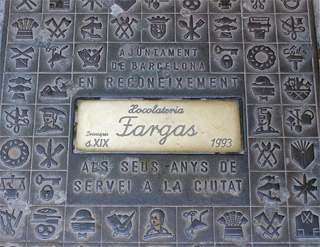 Establishments in
the same business, run by the same family, for at least
100 years are designated by square metal plaques, adorned
with symbols of the trade guilds, imbedded in the
sidewalks at their entrances. The plaques are engraved
with the name, date of inception, and the date the plaque
was awarded. Seeking out these historic institutions and
buildings added another dimension for us.
Establishments in
the same business, run by the same family, for at least
100 years are designated by square metal plaques, adorned
with symbols of the trade guilds, imbedded in the
sidewalks at their entrances. The plaques are engraved
with the name, date of inception, and the date the plaque
was awarded. Seeking out these historic institutions and
buildings added another dimension for us.
Heading south on the left is the
Baroque 17th century Palau Moja while across the way is
another Baroque beauty the Church of Betlem. From Carrier
Carme to Carria Hospital is a section flanked by huge
banana trees known as Rambla de les Flors with its flower
stalls.
[Back
to Top]
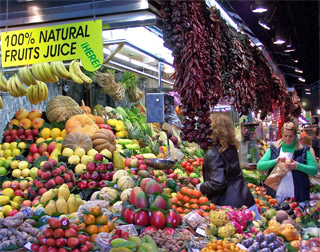 Next we came to
the famous Boqueria Market. Originally it was an open-air
market, a roof was installed in 1914 and it was remodeled
a while ago. It's a large, almost endless succession of
stalls beautifully presenting fine quality produce, meat,
fish, cheeses, breads, nuts, candies etc. at reasonable
prices. Three hundred families earn their living
operating the stalls.
Next we came to
the famous Boqueria Market. Originally it was an open-air
market, a roof was installed in 1914 and it was remodeled
a while ago. It's a large, almost endless succession of
stalls beautifully presenting fine quality produce, meat,
fish, cheeses, breads, nuts, candies etc. at reasonable
prices. Three hundred families earn their living
operating the stalls.
Further south is the Gran Teatre del Liceu. Within its very simple exterior is one of the largest, most opulent halls in the world. A block south is the Palau Guell by GaudÝ with its stone and wrought iron fašade and parabolic arches in the entrance hall. It has been designated as a World Heritage Site by UNESCO. Across the way is the gorgeous arcaded square, Plaša Reial, flanked by identical buildings, built in the mid 19th century. As we continued south we came to the Pla del Teatre, the city's first theater, built in the 16th century.
The lower part of La Rambla has no trees but we found the 17th century Church of Santa Monica with a lovely Baroque cloister (I love cloisters). It's now the center d'Art Santa Monica, an art and cultural center of the Generalitat. Across the way is a handsome 18th century building which is the seat of the Department of Culture of the Generalitat and exhibition center. There is a handicraft market held in this area on weekends.
We found ourselves constantly on
the Rambla, whether to buy a bottle of water, orange
juice or wine in the supermarket or on our way in or out
of Barri Gothic or just to enjoy the energy.
[Back
to Top]
The Barri Gothic is Barcelona's historical and political center. This former ancient fortified Roman City of Barcino is a treasure of charming narrow streets and squares home to historic monuments and modern institutions. In our wanderings we found some excellent restaurants, unique shops, interesting antique dealers, and examples of a book selling-tradition (Carrer Llibreteria).
Two well-preserved sections of the ancient Roman Walls and two Quadrangular towers from the city's second walled precinct greeted us in Plaša Nova. Nearby is the Cathedral of the Holy Cross. Construction began in the 13th century and the fašade was not completed until the late 19th. Inside, of particular note, are the primary altar and the crypt of Santa Eulalia. The cloister, which is accessed through a door next to the sacristy or off of Carrer Bisbe, a very narrow street that runs along the west side of the Cathedral, is a beauty with a central garden and pond.
Carrer Tapineria along another striking section of the Roman wall led to Plaša de Ramon Berenguer el Gran with the grand sight of the walls, the remains of the old Palau Reial Major, with a 40 meter bell tower, and the equestrian statue of Ramon Berenguer III.
Carrer Sots-tinent Navarro took us to Via Llibreteria into Plaša Del Rei in which are located the Great Royal Palace, The Chapel of St Agatha, City's Historical Museum, and Tinell Hall supported by 6 stone semi-circular arches. Ruins of the ancient Roman city are under this square.
Llibreteria then led to Plaša de Sant Jaume, site of the former Roman Forum and now appropriately the administrative center of the city. The Palau de la Generalitat (headquarters of the autonomous Government of Catalonia) is a 16th century renaissance era building. There is an imposing interior staircase and famous 16th century Courtyard of the Oranges. The 14th century Adjuntament (Town Hall) has a main neoclassic fašade facing the square and a Gothic fašade on Carrer Ciutat. The large attractive square was always humming with activity as this is the hub of the Gothic Quarter with adjoining streets running directly north-south and east-west, connecting all quarters of the old city and Plaša Catalunya to the waterfront.
Carrer dell Call runs west from
Plaša de Sant Jaume and connects to Carrer Banys Nous
and Carrer Palla which form the border of the old Jewish
Quarter which is called, El Call (Catalan for narrow
passage). We patrolled the narrow passageways in search
of the Sinagoga Medieval de
Barcelona and finally found
it at Carrer Marlet 5, near the corner of Carrer St.
Domenec dell Call which runs north of Carrer dell Call
just west of Plaša de Sant Jaume. 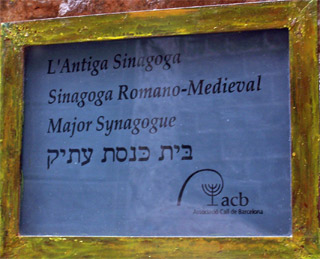
Watch your head on the steps because if you are not paying attention you will receive a nasty bump on your head, as I did. In this sub-basement are the remains of a 5th century synagogue on which the 14th century medieval synagogue was built. There is a small museum adjacent, with artifacts donated by Jews around the world.
The fact that the main fašade of
the building faces south-east toward Jerusalem confirmed
that this was indeed the location of medieval synagogue.
Later excavation laid bare the adjacent ancient Roman
walls of the Forum.
[Back
to Top]
Around the corner at Carrer Banys Nous 10, in the rear of S'Oliver furniture shop, are the remains of the ancient men’s baths. The staff was quite happy to direct us to the well-preserved pillars, arches and ceiling, now home to modern day furnishings.
Further down Banys Nous at the corner of Carrer La Palma is the Cafe Caelum in the basement of which is the remains of the mikves (women's baths). We were too early as they do not allow visitors until 16:00, so plan accordingly.
Today there about 6,000 to 8,000 Jewish people in Barcelona with two active Sephardic congregations, one Lubavitch and one Reform. There are many monuments of Jewish history in the city. On Montjuic (Jewish mountain) there is a Jewish cemetery and the castle has ancient tombstones on display. There is also the Plaša d'Anna Frank in the Gracia District with a bronze sculpture of the squares' namesake.
At the east end of Carrer de la
Palla is the delightfully tranquil and charming Plaša
Sant Felip Neri with the pretty baroque church of Sant
Felip Neri. At the other end of the street is Plaša de
Sant Josep Oriol next to beautiful, peaceful Plaša del
Pi with a church of the same name. The design is
representative of Catalan Gothic religious architecture.
It is famous for its enormous rose window and 54 metre
high octagonal bell tower. 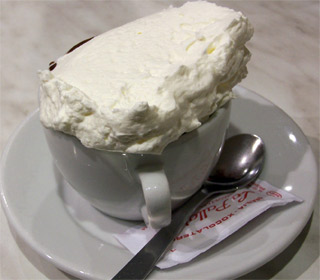
Nearby Carrer Petrixol is a
delightful old fashioned way with unique antique shops
and several well known "granajas", cafes that
specialize in dairy products and pastries. We understood
that Barcelona was famous for hot chocolate and that the
best was to be found at La Pallaresa on this street. The
windows of the shop feature displays of tantalizing
pastries and hot chocolate with and without whipped cream.
The chocolate was thick enough to be eaten with a spoon,
once you found your way through the awesome whipped cream,
though it was a bit too sweet for our taste.
[Back
to Top]
We had other eating experiences in the Gothic District. Granja M. Viader, Carrer Montjuic del Carme is the founder of bottled milk, chocolate milk and the famous hot chocolate. It's one of those businesses that qualified for a 100 year plus plaque in front of the entrance. The counter and cases are filled with authentic, traditional quality products, all home made. We passed on the hot chocolate but had a wonderful breakfast of mato (ricotta like cheese) with honey and walnuts, croissant and ensimada. The coffee was just okay.
Our favorite meals in the district
were at Los Caracoles, Escudellers 14. This restaurant is famous
for grilled chicken and, of course, caracoles (snails)
but we managed to find some other delights as well.
Besides having wonderful food, it's a fun place. It
starts at the front with chickens grilling in the window
and continues past a friendly, long bar into the open
kitchen, with chefs at flat grills and stove tops with
their sizzling skillets. The sight, sound and aroma of
meat and seafood preparation before our eyes stirred the
appetite as we were guided to a table around the corner.
There are many rooms on various levels where they can
handle private parties from 14 to 100 people. The
atmosphere is old wood and tile with walls covered with
photos of the famous who dined here. Crusty rolls arrived
in the shape of giant snails. We started with a mixed
salad and of course the caracoles. I unwrapped a
toothpick and plucked the first victim from its hideout
and was amazed at the size and tenderness of the plump
critter. The sauce was awesome, a mixture of tomato,
carrot, garlic, sweet red wine and hot pepper. The great
reputation is well deserved. The house red wine was light
and fruity. I had a half grilled chicken with crisp skin
and juicy flesh while Linda's grilled baby kid rib chops
were the love of her life. Our mains were served with
French fries and both were wonderful. We returned another
day to satisfy Linda's need for a repeat rib fest while I
had to try the grilled rabbit. The chops came through
again and the half of meaty rabbit was grilled to
perfection.
[Back
to Top]
A few doorways away is the popular
budget priced La Fonda, Escudellers, 10. There is
generally a long lineup but we arrived for a late lunch
and walked right in. It's a modern environment on two
levels. We were impressed with our fish soup and
shellfish cream soup, both were full of the flavor of
their respective ingredients. Linda had a spinach salad
which was okay while my hake in a crab sauce was rubbery
and the frozen vegetables and boiled potato were served
cool. I would prefer to pay a bit more and have better
quality and preparation. 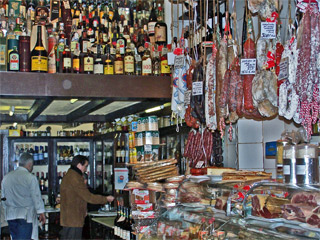
There are some wonderful specialty food shops in the district such as Pastisseria Escriba on La Rambla (a 100 year place) with showcases filled with mouthwatering pastries. Off Carrer Portaferrissa is a tiny marvelous delicatessen selling regional sausages, wines, cheeses etc. and for nougat lovers, don't miss Les Torroneries del Carrer de la Cucurulla, where they make the product on the premises in the traditional way. So many more, just stroll around and discover.
La Ribera, separated from the Gothic Quarter by Via Laietana, is an enchanting maze of streets which were originally home to the commerce and navigation guilds of Barcelona. Walking down Carrer Argenteria we came to Plaša de Santa Maria and the 14th century Church of Santa Maria del Mar (Basilica of Holy Mary of the Sea), a beautiful rendition of Catalonian gothic architecture. Three elegant soaring naves, fine stained glass windows and an impressive 15th century rose window are the highlights of this elegant structure.
Passeig del Born is a rectangular Plaša rather than a boulevard which, in the middle ages, was the site of tournaments and popular festivals. El Born is a very popular destination for locals and visitors, as it was on this sunny warm Sunday. Boasting an array of up-to-date restaurants, cafes, bars, shops and fashion stores, without losing its traditional flavor, it's a great place for people watching.
Carrer Montcada is a narrow way filled with medieval palaces many of which now house museums and art galleries. Five of these palaces now are home to the Museo Picasso. The comprehensive collection offers works from the artist's youth and formative years. Also highlighted is a series of interpretations of Velazquez's Las Meninas dating from 1957, ceramics and engravings.
Picasso addicts will want to find
Quatre Gats in the Gothic Quarter on Carrer Montisio, a
bar where Picasso regularly took part in intellectual
debates with his friends. There are many drawings and
paintings which bear witness to his time spent there. 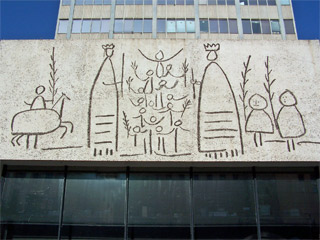 The building
housing the bar is a gothic beauty with sculptures
adorning the fašade and wonderful stone work around the
windows.
The building
housing the bar is a gothic beauty with sculptures
adorning the fašade and wonderful stone work around the
windows.
On the north side of Plaša Nova
where many streets come together is the Architects
building which displays the only piece of public art by
Picasso. Done by the Norwegian artist Carl Nesjar
according to the original designs by Picasso, there are
three friezes of the Mediterranean; the giants, the
children and the Catalan flag.
[Back
to Top]
Back in La Ribera, on Av. de Francesc is the inviting Mercat de Sta. Caterina. We were drawn to it by its distinctive wavy colorful roof and delighted to stroll the aisles of fresh food products. It is an updated version of the old Mercat de la Boqueria.
We had a few excellent dining experiences here in the Ribera. Usually we avoid restaurants that seem to appear on every list but this time we were convinced that 7 Portes 1836 at Passeig Isabel 11-14 was worth a try. We were not disappointed. While many tourists find their way here, it is a regular destination for the locals, for the past 170 years. The environment is refined traditional. There are many dining rooms and areas designed for comfort and privacy.
We started with large white asparagus served with 3 sauces; mayonnaise, salsa romesco (tomato, almonds, hazelnuts, vinegar), salsa verde (onion, gherkins, hard boiled egg, olive oil and vinegar). The asparagus alone was a treat, add the two salsa's and you're in heaven. Spinach-stuffed cannelloni is baked with a touch of cheese on top and luscious bÚchamel sauce. Service was friendly, helpful and professional. No rushing here, appropriate time between courses to digest and prepare for the next treat.
In spite of the fact we have never been paella lovers, we felt it was necessary to give it a try. We decided on paella parellada (fish and seafood only), called rich man's paella. This version was different from others we have had in the past in that it was deep brown in color. Flavored by the sauce called sofregit, a mixture of olive oil, onion, tomato, parsley, sage, garlic and other seasonings, it contained a good variety of ocean goodies but we must confess that we were not won over. It was a relaxing and very enjoyable lunch.
Al Xampanyet on Carrer de Montcada
has been serving tapas since 1929. This tiny ancient
place has just a few tables and a stand up counter on
which some of the day's offerings are displayed. It was
jam-packed when we arrived but we lucked-out when a
couple signaled us that they were leaving and we were
able to snag their table almost immediately. The waiter
was quickly with us and suggesting (in Spanish) various
delights. We are quick learners and were soon consuming
bread and oil, anchovies, sliced ham, hot pepper stuffed
with tuna, cheese and homemade potato chips. Linda had
wonderful sidre (cider) and I a beer. This was the real
Catalan experience. Happy folks enjoying simple foods and
good company.
[Back
to Top]
The final restaurant in Ribera worth mentioning is Origen 99.9%, Carrer Vidrieria. The entrance to the small dining room is through the shop where they sell wines, preserves, candy, etc. The menu is presented as part of a glossy magazine of their own production. There are full color photos of every offering with a brief description of the preparation. Prices are very reasonable for both the traditional and more creative offerings.
We were served bread sticks with two marvelous dips both with goat cheese as the base - one with garlic and olive oil, the other with figs and pineapple. Linda's chestnut and pumpkin soup was quite wonderful while my whole onion stuffed with meat was a first and fabulous. Linda found the preparation of the chicken with plums and pine kernels to be nicely flavored as was my wild boar stew. The chicken legs and boar were a bit tough, however. With better quality cuts it would have been really good but heck at these low prices, it was quite acceptable. The big negative is that they customarily serve all courses simultaneously and the service was poor. The place has potential but needs refining.
Down at the waterfront we headed for Barceloneta and strolled the length of Passeig de Juan de Borbon which borders the port. This esplanade is lined with seafood restaurants. The smell of fresh grilled shrimps, lobster and fish filled the air. The tables in front of each establishment were packed with eager diners and platters of seafood were piled high.
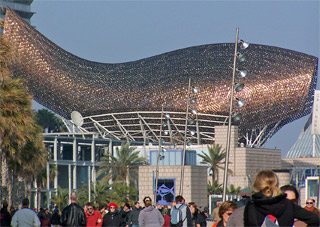 At the end of the
esplanade we came to the beachfront where locals were
strolling the boardwalk or taking sun on the sand. Not
too far away is the Olympic Port, easily recognized by
the towering graceful bronze metal sculpture of the
"Peix" (fish). This is a lively center for
relaxing over a snack, nice meal or your favorite
beverage surrounded by parks and beautiful beaches.
At the end of the
esplanade we came to the beachfront where locals were
strolling the boardwalk or taking sun on the sand. Not
too far away is the Olympic Port, easily recognized by
the towering graceful bronze metal sculpture of the
"Peix" (fish). This is a lively center for
relaxing over a snack, nice meal or your favorite
beverage surrounded by parks and beautiful beaches.
In six days we managed to explore many major sights and get a feel of the city. Like any big city it will take a lot more time to achieve a complete level of knowledge, understanding and comfort.
We do know that Barcelona is a very clean city. Both public and private businesses are constantly washing the sidewalks and streets. We saw graffiti being cleaned off a wall by city workers who carefully matched the paint color before repainting the damaged area.
The street and directional signing is flawless; it is very easy to find your way around. The transportation system is excellent and it is very easy to get to all parts of the city in an efficient manner.
The tourist organization does a superb job of marketing the city. Just go to the big "i" in Plaša Catalunya and downstairs you will get all the help you need and can book excellent bus and walking tours that are very worthwhile.
We found absolutely no language problems with our English and faint memories of high school Spanish. Barcelona is bi-lingual, Spanish and Catalan, which is different. Most menus are in Spanish, Catalan and English.
Vueling transported us back to Roma
with the same on-time efficiency that brought us to
Barcelona, the very civilized Catalan/Spanish city we
discovered during our winter trip to Italy!
[Back
to Top]
Search TheTravelzine | TheTravelzine Group | Don's Gallery
Packing Hints | Planning
Tips | Cities
Links
All pages on TheTravelzine.comęCopyright 1996-2020 Don & Linda Freedman